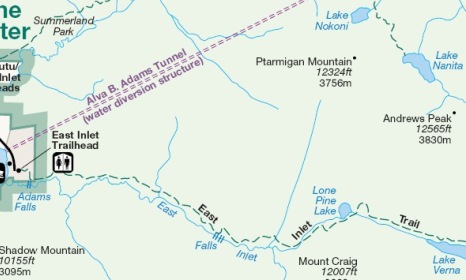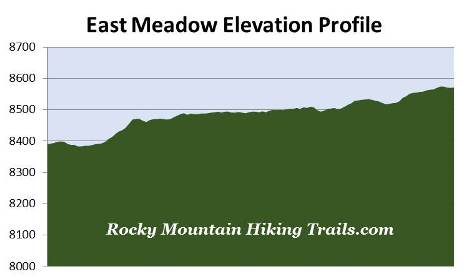
East Meadow
| Trail Features: | Scenic Views, Waterfalls, Wildlife | 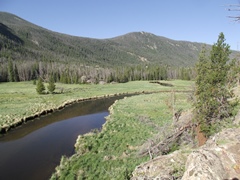 |
|||
| Trail Location: | East Inlet Trailhead | ||||
| Roundtrip Length: | 2.8 Miles | ||||
| Trailhead Elevation: | 8390 Feet | ||||
| Total Elevation Gain: | 235 Feet | ||||
| Avg. Elev Gain / Mile: | 168 Feet | ||||
| Highest Elevation: | 8574 Feet | ||||
| Trail Difficulty Rating: | 3.27 (easy) | ||||
| Parking Lot Latitude | 40.2398 | ||||
| Parking Lot Longitude | -105.80001 | ||||
Trail Description:
The hike to East Meadow begins from the East Inlet Trailhead near the town of Grand Lake on the west side of Rocky Mountain National Park. After turning into the Grand Lake area from Hwy 34 / Trail Ridge Road, drive three-tenths of a mile on West Portal Road until you reach a split in the road. Stay left at this junction and continue on West Portal Road for another 2 miles to reach the trailhead.
From the parking area the trail proceeds through a mixed forest of pine and aspens. After walking only one-third of a mile you'll reach the Adams Falls Trail, a semi-loop that reconnects with the East Inlet Trail in less than two-tenths of a mile. To visit the falls, turn right at this junction and walk the short distance to an overlook of Adams Falls, which drops roughly 55 feet in a series of steps through a narrow rock gorge.
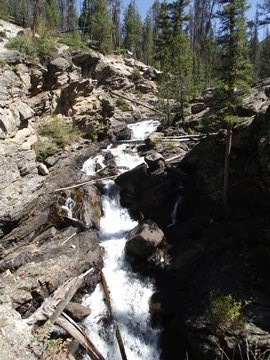 From the overlook the trail climbs to the top of the falls where you'll have another outstanding view from above. Looking off into the distance you'll also be able to see Grand Lake from this vantage point.
From the overlook the trail climbs to the top of the falls where you'll have another outstanding view from above. Looking off into the distance you'll also be able to see Grand Lake from this vantage point.
Although you may assume that the falls were named after Alva Adams, the former Colorado Senator for whom the nearby Alva B. Adams Tunnel is named after, the falls, as well as nearby Mt. Adams, are actually named for Jay E. Adams, an early settler who arrived in the Grand Lake area in the late 1800s. Prior to receiving its current name the waterfall was known as Ousel Falls.
From the top of the falls the semi-loop portion of the hike continues for a very short distance before linking up with the East Inlet Trail once again. To continue towards East Meadow you should turn right here.
The East Inlet Trail is an excellent example of National Park Service naturalistic design work. Both the National Park Service and the Civilian Conservation Corps built naturalistic designed trails that required the use of local materials, such as rock, wood and dirt, in order to harmonize with the local environment. It also required a maximum grade of 15%, a width of 3-4 feet, and has to meet sustainability standards through the use of stone steps, log checks, and log or stone culverts. As a result, the East Inlet Trail was listed on the National Register of Historic Places in 2005.
At roughly six-tenths of a mile hikers will reach the outskirts of East Meadow. Here you'll enjoy outstanding views of East Inlet Creek as it snakes through the valley under the gaze of Mount Cairns, Mount Craig and Mount Wescott. From here the trail circles around to skirt along the northern edge of this immense meadow.
At roughly 1.3 miles hikers will pass the East Meadow Campground, and at roughly 1.4 miles you'll reach a low bluff that offers commanding views of East Meadow and East Inlet Creek. This rock outcropping is also a great place to spot a variety of wildlife in the grassy meadows below, including moose, elk and deer. In fact, you may want to bring a pair of binoculars that will allow you to spot wildlife in far-off distances.
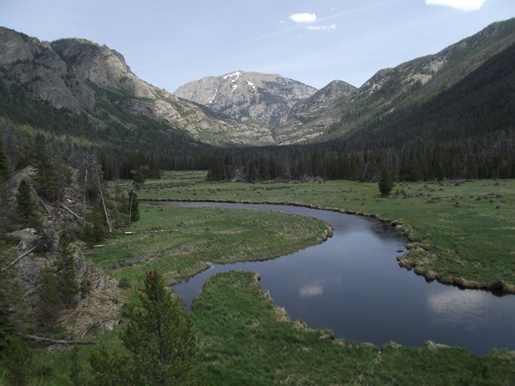
Although mornings and early evenings will provide the best opportunities for spotting wildlife, those timeframes may not be best for photographing the surrounding mountains since this valley is east-west oriented.
